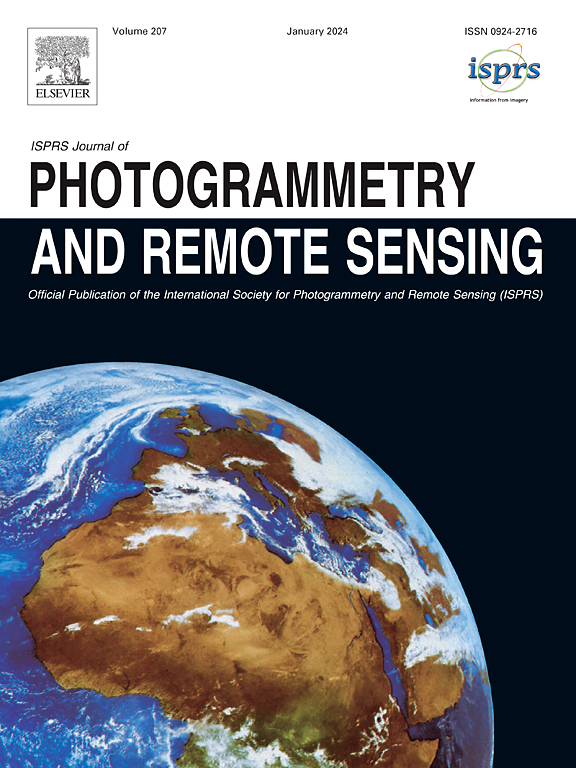DepthCD: Depth prompting in 2D remote sensing imagery change detection
IF 10.6
1区 地球科学
Q1 GEOGRAPHY, PHYSICAL
ISPRS Journal of Photogrammetry and Remote Sensing
Pub Date : 2025-06-13
DOI:10.1016/j.isprsjprs.2025.05.020
引用次数: 0
Abstract
Change detection with multi-temporal remote sensing images has wide applications in urban expansion monitoring, disaster response, and historical geographic information updating. In recent years, advancements in artificial intelligence have spurred the development of automatic remote sensing change detection methods. However, the existing change detection methods focus on variations in the spectral characteristics of objects, while ignoring the differences and variations in the Earth surface elevation of the different targets. This results in false alarms and missed detections in complex scenarios involving shadow occlusion, spectral confusion, and differences in imaging angles. In this paper, we present a depth prompting two-dimensional (2D) remote sensing change detection framework (DepthCD) that models depth/height changes automatically from 2D remote sensing images and integrates them into the change detection framework to overcome the effects of spectral confusion and shadow occlusion. During the feature extraction phase of DepthCD, we introduce a lightweight adapter to enable cost-effective fine-tuning of the large-parameter vision transformer encoder pre-trained by natural images. Inspired by domain knowledge of the dimensional correlation in land surface changes, we propose a depth change prompter to explicitly model depth/height changes at the feature, depth, and slope levels. In the change prediction phase, we introduce a binary change decoder and a semantic classification decoder that couple the depth change prompts with high-dimensional land-cover features, enabling accurate extraction of changed areas and accurate change types. Extensive experiments on six public change detection datasets validate the advantages of the DepthCD framework in binary and semantic change detection tasks. Detailed ablation studies further highlight the significance of the depth change prompts in remote sensing change detection.
深度提示:二维遥感图像变化检测中的深度提示
多时相遥感影像变化检测在城市扩张监测、灾害响应、历史地理信息更新等方面有着广泛的应用。近年来,人工智能的进步促进了自动遥感变化检测方法的发展。然而,现有的变化检测方法主要关注目标光谱特征的变化,而忽略了不同目标地表高程的差异和变化。这导致在涉及阴影遮挡、光谱混淆和成像角度差异的复杂场景中出现误报和漏检。本文提出了一种深度提示二维遥感变化检测框架(DepthCD),该框架可以自动模拟二维遥感图像的深度/高度变化,并将其整合到变化检测框架中,以克服光谱混淆和阴影遮挡的影响。在DepthCD的特征提取阶段,我们引入了一个轻量级的适配器,以实现由自然图像预训练的大参数视觉转换器编码器的经济微调。受陆地表面变化的维度相关性的领域知识的启发,我们提出了一个深度变化提示符来明确地模拟地物、深度和坡度水平上的深度/高度变化。在变化预测阶段,我们引入了二元变化解码器和语义分类解码器,将深度变化提示与高维土地覆盖特征相结合,实现了变化区域和变化类型的准确提取。在六个公共变更检测数据集上的大量实验验证了DepthCD框架在二进制和语义变更检测任务中的优势。详细的消融研究进一步凸显了深度变化提示在遥感变化检测中的重要意义。
本文章由计算机程序翻译,如有差异,请以英文原文为准。
求助全文
约1分钟内获得全文
求助全文
来源期刊

ISPRS Journal of Photogrammetry and Remote Sensing
工程技术-成像科学与照相技术
CiteScore
21.00
自引率
6.30%
发文量
273
审稿时长
40 days
期刊介绍:
The ISPRS Journal of Photogrammetry and Remote Sensing (P&RS) serves as the official journal of the International Society for Photogrammetry and Remote Sensing (ISPRS). It acts as a platform for scientists and professionals worldwide who are involved in various disciplines that utilize photogrammetry, remote sensing, spatial information systems, computer vision, and related fields. The journal aims to facilitate communication and dissemination of advancements in these disciplines, while also acting as a comprehensive source of reference and archive.
P&RS endeavors to publish high-quality, peer-reviewed research papers that are preferably original and have not been published before. These papers can cover scientific/research, technological development, or application/practical aspects. Additionally, the journal welcomes papers that are based on presentations from ISPRS meetings, as long as they are considered significant contributions to the aforementioned fields.
In particular, P&RS encourages the submission of papers that are of broad scientific interest, showcase innovative applications (especially in emerging fields), have an interdisciplinary focus, discuss topics that have received limited attention in P&RS or related journals, or explore new directions in scientific or professional realms. It is preferred that theoretical papers include practical applications, while papers focusing on systems and applications should include a theoretical background.
 求助内容:
求助内容: 应助结果提醒方式:
应助结果提醒方式:


